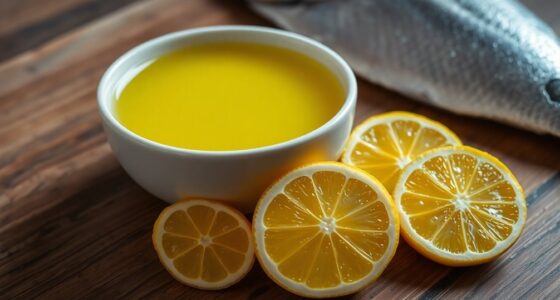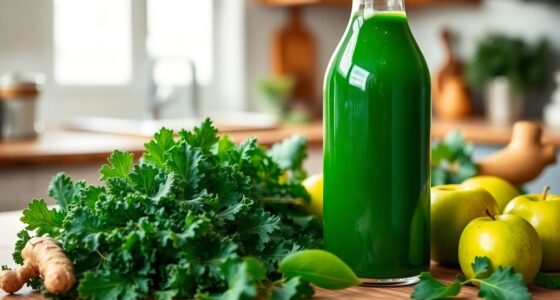To make jungle juice with alcohol, mix one part vodka or rum with three parts tropical fruit juices, like pineapple and orange. Stir well in a large punch bowl, then chill for several hours to enhance the flavors. Toss in fresh fruit slices like oranges and strawberries for added flair and taste. Serve over ice in cups, and let guests customize their drinks by adding more alcohol if they prefer. Discover more tips for the perfect blend! For an exciting twist, consider incorporating different fruit juices, such as mango or guava, to create a unique blend that complements the tropical vibe. If you’re interested in expanding your beverage repertoire, learning how to prepare lychee juice can add a delightful sweetness to your jungle juice. Remember to garnish each cup with additional fruit slices or even mint leaves for a refreshing touch that will impress your guests!
Key Takeaways
- Choose a mix of fruit juices like pineapple, orange, and lemonade for a tropical flavor profile.
- Combine one part alcohol (vodka or rum) with three parts juice in a large punch bowl.
- Stir the mixture well and refrigerate for several hours to enhance flavor blending.
- Add fresh fruit slices, such as oranges, strawberries, and pineapples, for added taste and visual appeal.
- Serve over ice and provide a separate container for alcohol to allow guests to customize their drinks.

When you're planning a party and want to serve something fun and refreshing, jungle juice is the perfect choice. This easy Jungle Juice recipe combines a variety of fruit juices with alcohol to create a tropical punch that will keep your guests coming back for more. With just a few simple steps, you can whip up a delicious punch drink that's sure to impress.
Start by gathering your ingredients. You'll need a selection of fruit juices like pineapple juice, orange juice, and lemonade. These juices provide a flavorful base for your punch drink. You can mix and match based on your preferences, but make sure to keep the tropical vibe alive.
Next, you'll want to add in your alcohol. Vodka and rum work wonderfully for jungle juice, giving it that extra kick. If you're looking to save a little cash, low-cost vodka and rum are perfectly acceptable. Just be sure to adjust the quantities of your juices to control the drink's strength.
Once you have your juices and alcohol ready, it's time to mix the alcohol. In a large punch bowl, combine the fruit juices with your chosen alcohol. The proportions can vary, but a good starting point is about one part alcohol to three parts juice. Stir the mixture well to ensure everything is blended.
After mixing, chill the jungle juice in the refrigerator for several hours. This helps enhance the blending of flavors, making each sip more delicious.
For an extra touch, consider adding fresh fruit. Slices of oranges, strawberries, and pineapples not only add visual appeal but also infuse the drink with even more flavor. You can toss the fresh fruit into the punch bowl before serving, giving guests the option to enjoy some fruity goodness in their cups.
When it's time to serve, fill cups with ice and pour the jungle juice over. This keeps the drink cold and refreshing throughout your party.
You might want to provide a separate container for the alcohol, so guests can customize their drinks if they prefer a stronger punch. This way, everyone can enjoy their jungle juice just the way they like it.
With a typical yield of 2 to 2.5 gallons, this recipe makes about 32 servings, making it ideal for gatherings and parties.
Frequently Asked Questions
What Is Jungle Juice Made Of?
Jungle juice is a fun, fruity drink made from a mix of various fruit juices like orange, pineapple, and lemonade.
You'll often find it packed with fresh or frozen fruits such as strawberries and oranges for an extra burst of flavor.
Some people add tropical juices like fruit punch or cranberry to enhance the taste.
The combination creates a vibrant, refreshing beverage that's perfect for parties and gatherings, appealing to everyone's taste buds.
What Is the Alcohol Content of Jungle Juice?
They say, "What you don't know can't hurt you," but that's not true with Jungle Juice.
The alcohol content usually hovers around 20% ABV, but it can vary based on the mix of alcohol and juice. The fruity flavors can mask the strength, making it easy to underestimate.
What's the Best Alcohol to Mix With Juice?
When you're mixing alcohol with juice, vodka's a great choice due to its neutral flavor, letting the juice shine.
If you want a tropical twist, white rum adds a nice sweetness.
Triple sec can enhance citrus notes, especially with orange juice.
For something unique, try flavored vodkas like peach or citrus—they'll elevate your drink.
If you're feeling bold, a splash of Everclear can boost the kick, but be cautious!
What Are the Components of Jungle Juice?
Picture a tropical paradise in a glass; that's what jungle juice embodies. Its vibrant components typically include a medley of fruit juices like orange and lemonade, creating a refreshing base.
You'll find common alcohols like vodka and rum swirling in the mix, often sweetened with triple sec. Fresh fruits—think oranges, strawberries, and pineapples—dance atop the concoction, while a splash of soda adds a fizzy finish, making every sip a celebration.
Conclusion
Now that you've mastered the art of jungle juice, it's time to let the good times roll! With a splash of creativity and a dash of fun, you'll have a party favorite that'll keep everyone dancing till dawn. Just remember, like a wild river, it's all about balance—too much of a good thing can tip the scales. So mix wisely, enjoy responsibly, and let the vibrant flavors take you on an unforgettable adventure! Cheers!
Cindy thoroughly researches juicing trends, techniques, and recipes to provide readers with practical advice and inspiration. Her writing style is accessible, engaging, and designed to make complex concepts easy to understand. Cindy’s dedication to promoting the advantages of juicing shines through her work, empowering readers to make positive changes in their lives through the simple act of juicing.











